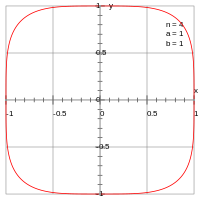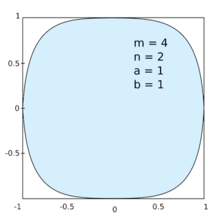超橢圓



超橢圓(英語:superellipse)也稱為拉梅曲線(Lamé curve),是在笛卡儿坐标系下滿足以下方程式的點的集合:
其中n、a及b為正數。
上述方程式的解會是一個在−a ≤ x ≤ +a及−b ≤ y ≤ +b長方形內的封閉曲線,參數a及b稱為曲線的半直徑(semi-diameters)。
n在0和1之間時,超橢圓的圖形類似一個曲線的四角星,四邊的曲線往內凹。
n為1時,超橢圓的圖形為一菱形,四個頂點為(±a, 0)及(0, ±b)。n在1和2之間時,超橢圓的圖形類似菱形,四個頂點位置相同,但四邊是往外凸的曲線,越接近頂點,曲線的曲率越大,頂點的曲率趨近無限大。
n為2時,超橢圓的圖形即為橢圓(若a = b時則為一個圓形)。當n大於2時,超橢圓的圖形看似四角有圓角的長方形,曲線的曲率在(±a, 0)及(0, ±b)四點為0。n為4的超橢圓也稱為方圓形。
n < 2的超橢圓也稱為次椭圆(hypoellipse),n > 2的超橢圓則稱為過椭圆(hyperellipse)。
當n ≥ 1,且a = b=1時的超橢圓是二維Lp空间下的單位圓,n即為其p-範數。
超橢圓的極點為(±a, 0)及(0, ±b),而其四個「角」為(±sa, ±sb),其中 。
數學性質
當n為一個非零的有理數p/q(最簡分數形式),則超橢圓為一平面代數曲線。若n為正數,其曲線次數為pq,若n為負數,其曲線次數為2pq。若a和b均為1且n為偶數,則此超橢圓為一n次的費馬曲線,此時超橢圓沒有奇點,但一般而言超橢圓中會有有奇點。

超橢圓的參數方程如下:
或
超橢圓內的面積可以用Γ函数Γ(x)來表示:
- =
其垂足曲線較容易計算,而以下曲線的垂足曲線
可以用極坐標方式來表示[1]:
延伸

超橢圓可以延伸為以下的形式:
或
其中的不是表示角度,只是方程式的一個參數。
歷史
超橢圓在笛卡兒坐標系下的表示式是由1795年出生的法國數學家加布里埃爾·拉梅,由椭圓的方程式擴展而得。

字體設計師赫爾曼·察普夫在1952年設計的Melior字體,利用超橢圓作為字母o的外形。三十年後高德納設法選擇了介於橢圓及超橢圓之間的曲線(兩者都用样条函数近似),作為他的Computer Modern字體。
1959年時瑞典斯德哥尔摩提出了其市中心賽格爾廣場圓環的設計競賽。丹麥詩人皮亞特·海恩(1905–1996)的設計以是一個n = 2.5,a/b = 6/5的超橢圓為基礎[2]。他的說明如下:
- 人是唯一一種會畫線然後將自己絆倒的動物。整個文明的推進有二個不同的取向:一種以直線及長方形為主,另一種則圓弧線為主。二種取向都有其機構上及心理上的原因。直線的事物可以放在一起,節省空間。而圓的東西很簡單,容易移動。但我們常常會陷入要在二者中選擇一個的困境,此時往往是介於二者中間的事物會更合適。隨意繪製的作品-例如以往在斯德哥尔摩出現過的圓環-無法達到這一點。它不是一個固定的形狀,也不像圓或方形有明確的定義,在美感上有所不足。超橢圓解決了這一個問題,它介於圓和長方形之間,既不是圓也不是長方形。它是一個有固定形狀、有明確定義的一個整體。
賽格爾廣場在1967年完成,而皮亞特·海恩繼續在其他的藝術品中使用超橢圓,包括牀、碟子、桌子等[3]。皮亞特·海恩將超橢圓以長軸為軸心旋轉,形成了一個立體的超級蛋,其特點是可以平面上直立,不會倒下,因此變成一個特別的玩具。
1968年在巴黎在為越戰談判時,談判者不滿意談判桌的外形,Balinski、Kieron Underwood及Holt在一封寄給紐約時報的信件中建議以超橢圓作為談判桌的外形[2]。1968年由墨西哥城主辦奧運時,也以超橢圓為阿茲特克體育場的外形。
相關條目
參考資料
- ^ J. Edwards. Differential Calculus. London: MacMillan and Co. 1892: 164.
- ^ 2.0 2.1 Gardner, Martin, Piet Hein’s Superellipse, Mathematical Carnival. A New Round-Up of Tantalizers and Puzzles from Scientific American, New York: Vintage Press: 240–254, 1977, ISBN 978-0-394-72349-5
- ^ The Superellipse (页面存档备份,存于互联网档案馆), in The Guide to Life, The Universe and Everything by BBC (27th June 2003)
- ^ Tobler, Waldo, The hyperelliptical and other new pseudocylindrical equal area map projections, Journal of Geophysical Research, 1973, 78 (11): 1753–1759, Bibcode:1973JGR....78.1753T, doi:10.1029/JB078i011p01753.
Text is available under the CC BY-SA 4.0 license; additional terms may apply.
Images, videos and audio are available under their respective licenses.











